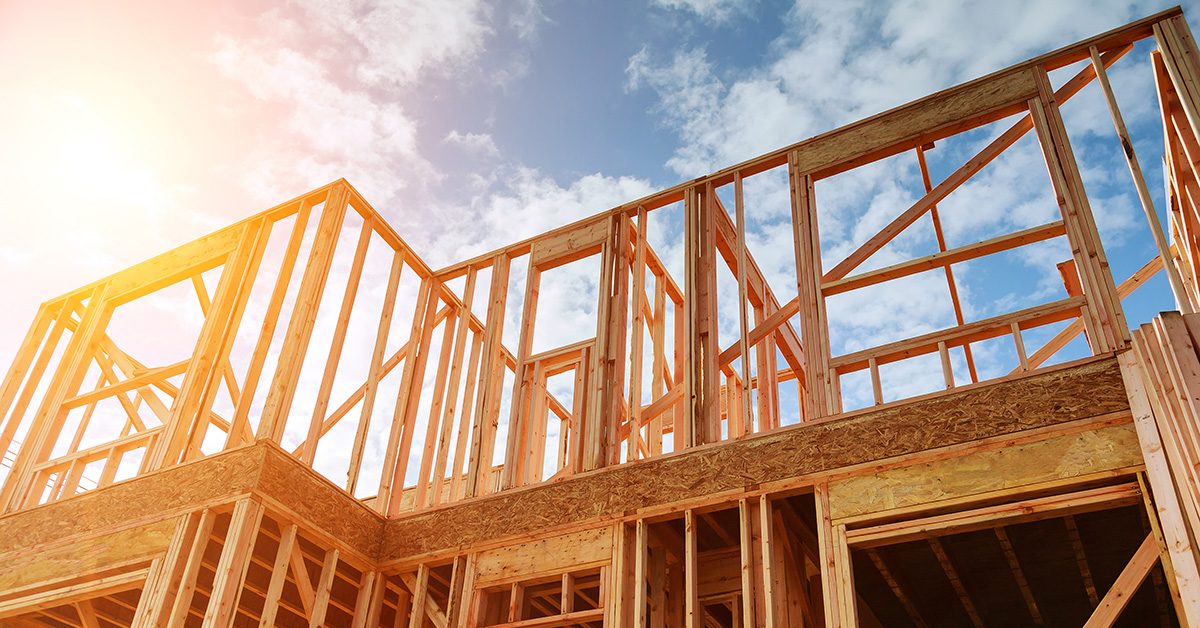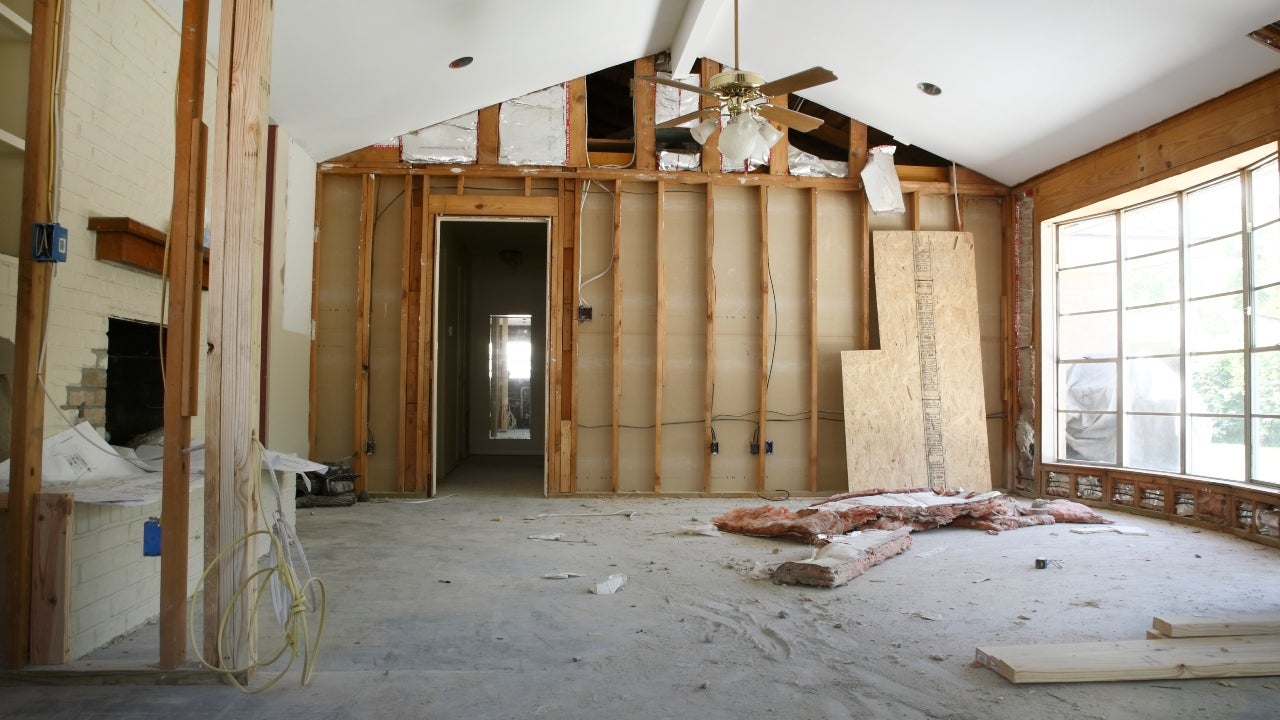Home>diy>Building & Construction>How To Get Construction Loan From Bank


Building & Construction
How To Get Construction Loan From Bank
Modified: March 6, 2024
Learn how to secure a construction loan from a bank for your building construction project. Expert tips and strategies for successful loan approval.
(Many of the links in this article redirect to a specific reviewed product. Your purchase of these products through affiliate links helps to generate commission for Storables.com, at no extra cost. Learn more)
Introduction
Building your dream home or undertaking a major renovation project can be an exciting but expensive endeavor. Fortunately, construction loans can provide the necessary funds to turn your architectural vision into a reality. However, acquiring a construction loan from a bank can be a complex process that requires careful planning and preparation.
In this article, we will delve into the world of construction loans and guide you through the steps to obtain one from a bank. Whether you’re a first-time homeowner or an experienced builder, understanding the ins and outs of construction loans is crucial to successfully finance your construction project.
So, let’s begin by exploring what construction loans are and how they differ from traditional mortgages.
Key Takeaways:
- Construction loans are short-term, variable interest loans that disburse funds in stages as the construction progresses. It’s crucial to carefully plan, estimate costs, and meet bank requirements to secure a loan.
- Finding the right bank, understanding loan terms, and effectively managing construction loan funds are essential for successfully financing your construction project. Open communication and diligent financial record-keeping are key.
Read more: What Banks Offer A Construction Loan
Understanding Construction Loans
Construction loans are specialized loans designed to fund the construction or renovation of a property. Unlike traditional mortgages where the full loan amount is disbursed upfront, construction loans disburse funds in stages, known as draws, as the construction progresses.
One key aspect of construction loans is that they are typically short-term loans, with a duration of 6 to 24 months. During this period, the borrower typically pays interest-only payments on the loan. Once the construction is complete, the loan is typically converted into a permanent mortgage, allowing the borrower to pay off the entire loan amount over a longer term.
Construction loans usually have variable interest rates, meaning that the interest rate fluctuates over time based on market conditions. This can provide both advantages and disadvantages to borrowers, as they may benefit from lower interest rates in the future, but can also be subject to higher rates if market conditions worsen.
Another important aspect of construction loans is that they require a comprehensive understanding and management of the construction process. Lenders want to ensure that the funds are being used efficiently and that the project is progressing as planned. To facilitate this, borrowers are often required to provide detailed construction plans, cost estimates, timelines, and regular progress updates throughout the construction phase.
Now that we’ve laid the foundation of construction loans, let’s move on to the crucial steps you need to take in order to prepare for and obtain a construction loan from a bank.
Preparing for a Construction Loan
Before you start the process of obtaining a construction loan from a bank, it’s important to be well-prepared to increase your chances of success. Here are some key steps to take in preparation:
- Develop a detailed construction plan: Before approaching a bank, you need to have a clear and comprehensive construction plan in place. This includes architectural drawings, blueprints, a list of materials, and a detailed timeline of construction milestones. The bank will review your plan to assess the feasibility and estimated cost of the project.
- Estimate the total cost: It’s crucial to accurately estimate the total cost of the construction project. This includes not just the materials and labor but also any other expenses such as permits, inspections, and architectural or engineering fees. Banks will want to see a detailed breakdown of these costs to determine the loan amount.
- Assess your budget: Take an honest look at your financial situation and evaluate how much you can realistically afford to allocate towards the construction project. Consider factors such as your income, savings, and any existing debt or financial obligations. This will help you determine the size of the loan you’ll need and ensure you’re not overextending yourself financially.
- Check your credit score: A good credit score is essential when applying for a construction loan. Lenders use your credit score to assess your creditworthiness and determine the interest rate you’ll qualify for. Get a copy of your credit report and address any issues or discrepancies before applying for the loan.
- Gather the necessary documentation: Banks will require specific documentation to evaluate your loan application. This typically includes tax returns, financial statements, bank statements, proof of income, and personal identification. Prepare these documents in advance to streamline the loan application process.
- Save for a down payment: Some banks may require a down payment for construction loans, usually around 20% of the estimated project cost. Start saving early to ensure you have enough funds available when it’s time to secure the loan.
By proactively taking these steps and being well-prepared, you’ll be in a strong position to approach banks and secure a construction loan for your project. In the next section, we’ll delve into finding the right bank for your construction loan needs.
Finding the Right Bank
When it comes to obtaining a construction loan, selecting the right bank is essential. Not all banks offer construction loans, and even among those that do, the terms and requirements can vary significantly. Here are some key factors to consider when finding the right bank for your construction loan:
- Research banks that offer construction loans: Start by researching banks that specialize in construction loans. Look for reputable banks with experience in financing construction projects. Check their websites, read reviews, and ask for recommendations from builders or contractors who have worked with them before.
- Consider local banks: Local community banks may be a good option as they often have a better understanding of the local construction market and may offer more favorable terms. They may also be more flexible in working with borrowers and providing personalized service.
- Evaluate loan terms and interest rates: Compare the terms and conditions offered by different banks. Look for competitive interest rates, reasonable fees, and flexible loan terms that align with your specific needs and financial situation. Pay attention to the loan-to-value ratio (LTV) the bank is willing to offer, as this will determine the percentage of the project cost they are willing to finance.
- Assess the bank’s experience and track record: Choose a bank that has experience in financing construction projects similar to yours. Look for a bank that has a good track record of successfully disbursing construction loans in a timely manner, as delays in loan disbursement can cause disruptions in the construction process.
- Consider customer service and support: Construction loans can be complex, so it’s important to choose a bank that provides excellent customer service and support throughout the loan process. Look for a bank with knowledgeable loan officers who can guide you through the application and approval process and address any concerns or questions you may have.
- Seek recommendations and referrals: Reach out to builders, contractors, or real estate professionals in your area for recommendations on banks they have had positive experiences with. They can provide valuable insights and suggestions based on their firsthand experience working with different banks.
Take the time to research and compare different banks to find the one that offers the best fit for your construction loan needs. Once you’ve identified a bank, it’s important to understand and meet their specific requirements, which we’ll explore in the next section.
Meeting the Bank’s Requirements
When applying for a construction loan from a bank, it’s important to understand and meet the specific requirements set by the lender. These requirements ensure that you are a suitable borrower and that the construction project is viable. Here are some common requirements that banks may have:
- Creditworthiness: Banks will evaluate your creditworthiness by reviewing your credit score, credit history, and debt-to-income ratio. A good credit score demonstrates your ability to handle credit responsibly and increases your chances of loan approval. It’s important to have a healthy credit profile before applying for a construction loan.
- Construction experience: Some banks may require borrowers to have prior experience in construction or building projects. This is to ensure that you have the necessary knowledge and expertise to manage the construction process effectively.
- Proof of income: You’ll need to provide proof of stable income to demonstrate your ability to repay the loan. This can include pay stubs, tax returns, and other financial documentation that show consistent earnings.
- Project feasibility: Banks will assess the feasibility of your construction project to ensure that it is viable and likely to be completed successfully. This includes reviewing your construction plans, cost estimates, and timeline to determine if they align with industry standards and market conditions.
- Appraisal and inspections: Banks will typically require an appraisal of the property to assess its value, as well as regular inspections throughout the construction process to ensure that the project is progressing as planned. These evaluations help protect the bank’s investment and ensure that the project meets all regulatory and safety requirements.
- Down payment: Depending on the bank’s requirements, you may need to provide a down payment for the construction loan. This is typically a percentage of the total project cost, and it helps demonstrate your commitment to the project and reduce the lender’s risk.
Meeting these requirements is crucial to obtaining a construction loan from a bank. It’s important to carefully review the specific requirements of the bank you’re working with and ensure that you have all the necessary documentation and qualifications in place before applying for the loan.
Next, let’s explore how to determine the loan amount and terms that best suit your construction project and financial situation.
Determining Loan Amount and Terms
When it comes to construction loans, determining the loan amount and terms is a crucial step in the process. The loan amount should cover the total cost of the construction project, including materials, labor, permits, and other associated expenses. Here are some factors to consider when determining the loan amount and terms:
- Project cost estimation: Start by estimating the total cost of your construction project. This includes detailed cost breakdowns for materials, labor, permits, and any additional expenses. Working with architects, contractors, or professionals experienced in construction cost estimation can help ensure accuracy.
- Loan-to-value (LTV) ratio: Banks often set a maximum loan-to-value ratio, meaning they will provide a loan amount that is a certain percentage of the appraised value of the property. Typically, the LTV ratio for construction loans ranges from 80% to 95%. The specific LTV ratio depends on the bank’s policies, your creditworthiness, and the feasibility of the project.
- Down payment: Determine how much you can afford to contribute as a down payment. This is often a percentage of the total project cost, typically ranging from 10% to 30%. The higher the down payment, the lower the loan amount you’ll need to borrow.
- Interest rate: The interest rate on your construction loan will impact both your monthly payments during the construction phase and the overall cost of the loan. Factors that affect the interest rate include your credit score, market conditions, and the bank’s offerings. Shop around and compare interest rates from different banks to secure the most favorable terms.
- Loan term: Construction loans are typically short-term loans, ranging from 6 to 24 months. During this period, you’ll only have to make interest payments. Once construction is complete, the loan is typically converted into a permanent mortgage with a longer-term repayment plan. Consider the length of the construction phase and choose a loan term that aligns with your project timeline.
- Repayment plan: Discuss with the bank the repayment options available for the permanent mortgage. Determine the repayment term and structure that best suits your financial situation and long-term goals. This typically involves deciding between fixed-rate mortgages, adjustable-rate mortgages, or other loan options offered by the bank.
By carefully assessing the project costs, working within the bank’s loan-to-value ratio, considering your down payment, negotiating favorable interest rates, and choosing an appropriate loan term and repayment plan, you can determine the loan amount and terms that align with your construction project and financial situation.
Now, let’s move on to the process of submitting a loan application to the bank.
Before applying for a construction loan, make sure to have a detailed construction plan, a good credit score, and a solid financial history. Be prepared to provide a down payment and collateral to secure the loan.
Submitting Loan Application
Once you have gathered all the necessary documentation and determined the loan amount and terms, it’s time to submit your loan application to the bank. The loan application process can vary slightly depending on the bank, but here are the general steps involved:
- Contact the bank: Reach out to the bank you have selected for your construction loan and schedule a meeting with a loan officer. This initial consultation will allow you to discuss your construction project, ask questions, and gather information about the loan application process.
- Complete the application: Fill out the loan application form provided by the bank. This form will require detailed information about your personal and financial background, employment history, income, assets, and liabilities. Be thorough and accurate in completing the application to avoid any delays or issues during the review process.
- Submit supporting documentation: Along with the loan application form, you will need to submit supporting documentation that verifies the information on your application. This can include tax returns, pay stubs, bank statements, proof of assets, property information, construction plans, estimated costs, and any other documentation required by the bank.
- Pay any associated fees: Some banks may charge application fees or other processing fees when you submit your loan application. Make sure to inquire about these fees upfront and be prepared to pay them at the time of application.
- Wait for loan review: Once you have submitted your loan application and supporting documents, the bank will review your application. This process may take several weeks as the bank evaluates your creditworthiness, project feasibility, and overall financial situation.
- Provide additional information if requested: During the review process, the bank may request additional information or clarification on certain aspects of your application or supporting documents. Respond promptly and provide the requested information to keep the process moving forward smoothly.
- Receive loan approval: If your loan application is approved, you will receive an official loan approval letter from the bank. This letter will outline the loan amount, terms, and conditions, including any additional requirements or stipulations for the loan disbursement process.
Once you have received loan approval, you can move forward with the next steps in the loan process, including the disbursement of funds and managing the construction loan throughout the project.
In the next sections, we’ll explore the loan disbursement process and how to effectively manage the construction loan funds.
Loan Approval Process
After submitting your loan application, the bank will begin the process of reviewing and approving your construction loan. This process involves a thorough evaluation of your financial information, creditworthiness, and the feasibility of your construction project. Here are the general steps of the loan approval process:
- Application review: The bank will review your loan application, including your personal and financial information, credit history, employment history, and supporting documentation. They will verify the accuracy of the information provided and assess your eligibility for the loan.
- Credit check: As part of the review process, the bank will conduct a credit check to evaluate your creditworthiness. They will assess your credit score and credit history to determine if you have a track record of responsible borrowing and repayment.
- Property appraisal: The bank may request an independent appraisal of the property to determine its value. This appraisal helps verify that the loan amount requested aligns with the property’s estimated worth.
- Project evaluation: The bank will assess the feasibility of your construction project by reviewing the construction plans, cost estimates, and timeline. They want to ensure that the project is realistic, well-planned, and likely to be completed successfully within the allocated loan amount.
- Financial assessment: The bank will also evaluate your financial situation and repayment capacity. They will consider your income, assets, liabilities, and debt-to-income ratio to determine if you have the financial ability to repay the loan.
- Loan committee review: In some cases, the loan application may be reviewed by a loan committee or underwriting team within the bank. They will carefully evaluate all aspects of your application to make a final decision on loan approval.
- Loan approval decision: After completing the evaluation and review process, the bank will notify you of their decision regarding the loan approval. If approved, the bank will provide an official loan approval letter outlining the loan amount, terms, and conditions.
It’s important to note that the loan approval process can take time, ranging from a few weeks to a couple of months. It’s always a good idea to communicate regularly with your loan officer and provide any requested information promptly to expedite the process.
Once your loan has been approved, you can move forward with the loan disbursement and start managing the construction loan funds effectively, which we’ll cover in the next section.
Loan Disbursement
Once your construction loan has been approved, the next step is the loan disbursement process. This is when the bank releases funds to finance the construction project in stages, known as draws. Here’s an overview of the loan disbursement process:
- Draw schedule agreement: The bank and borrower will agree upon a draw schedule, which outlines when and how funds will be disbursed throughout the construction process. This schedule is typically based on specific milestones or stages of completion.
- Inspections and evaluations: Before each draw, the bank will conduct inspections and evaluations to ensure that the construction is progressing as planned. This may involve site visits and assessments by a qualified inspector or appraiser to verify the completion of specific construction milestones.
- Payment requests: As the construction reaches each milestone, the borrower will submit payment requests to the bank. These requests typically include documentation, such as invoices, receipts, and proof of completed work, to confirm that the funds are being used for the intended purposes.
- Bank review and approval: The bank will review the payment requests and supporting documentation to assess the eligibility for fund disbursement. They will verify that the work has been completed satisfactorily and that the funds requested align with the agreed-upon draw schedule.
- Disbursement of funds: Once the bank approves the payment requests, they will release the funds for that specific draw. The funds are then transferred to the borrower’s account or directly to the contractors/vendors involved in the construction project.
- Repeating the process: The loan disbursement process repeats for each subsequent milestone or draw as outlined in the agreed-upon draw schedule. This continues until the construction project reaches completion.
It’s important to note that the bank may retain a portion of the loan funds, known as a contingency reserve, to address any unexpected costs or changes during the construction process. This reserve is usually held until the final stages of construction to ensure that there are sufficient funds to complete the project.
Throughout the loan disbursement process, it’s essential to maintain open and regular communication with the bank, submitting payment requests promptly and providing any necessary documentation to facilitate the smooth release of funds.
Now that we’ve covered the loan disbursement process, let’s move on to understanding how to effectively manage the construction loan funds.
Read more: How To Get Church Construction Loans
Managing Construction Loan Funds
Effective management of construction loan funds is crucial to ensure that the project stays on track and the funds are utilized efficiently. Here are some key tips to help you manage your construction loan funds:
- Create a detailed budget: Develop a comprehensive budget that outlines all anticipated costs and expenses related to the construction project. This includes materials, labor, permits, inspections, and any other necessary expenditures. Having a detailed budget will help you track expenses and avoid overspending.
- Monitor costs and expenses: Keep a close eye on costs and expenses throughout the construction process. Regularly review invoices, receipts, and payment requests to ensure that all expenditures are justified and align with the budget. If there are any unexpected expenses or changes, adjust the budget accordingly and communicate with the bank.
- Communicate with contractors and suppliers: Maintain open and regular communication with your contractors, suppliers, and vendors. Keep them informed of the payment schedule and any changes to avoid misunderstandings or delays. Address any concerns or issues promptly to maintain a smooth flow of work and payments.
- Track milestones and progress: Monitor the progress of the construction milestones outlined in the draw schedule. Keep records of completed milestones, including photographs and documentation, to support payment requests. Regularly update the bank on the progress to ensure timely and accurate disbursement of funds.
- Use funds for intended purposes: Ensure that construction loan funds are used only for the intended purposes outlined in the loan agreement. Use the funds to pay for approved construction expenses and avoid diverting them for personal use or unrelated expenses. Mismanagement of funds can lead to complications and may affect the loan agreement.
- Maintain accurate financial records: Keep organized financial records and documentation related to the construction project. This includes contracts, invoices, receipts, and payment records. Accurate records will help during audits, tax filings, and if any disputes arise during or after the construction process.
- Regularly communicate with the bank: Maintain open and transparent communication with the bank throughout the construction process. Provide updates on the progress, promptly submit payment requests, and address any concerns or inquiries from the bank. Regular communication helps build trust and ensures that the loan disbursement process runs smoothly.
By diligently managing the construction loan funds, you can ensure that the project stays on budget, vendors and contractors are paid on time, and the construction progresses as planned. Effective management of funds minimizes financial risks and increases the chances of a successful construction project.
Now that you have a good understanding of how to manage construction loan funds, it’s time to wrap up our discussion.
Conclusion
Obtaining a construction loan from a bank can be a complex process, but with careful planning and preparation, it is possible to secure the necessary funds to bring your construction project to life. Understanding the nuances of construction loans, finding the right bank, meeting their requirements, and managing the loan funds are all essential steps in this journey.
In this article, we explored the fundamental aspects of construction loans, including their purpose, structure, and the importance of thorough planning. We discussed the significance of preparing a detailed construction plan, estimating project costs, assessing your budget, and checking your credit score before approaching a bank.
We then delved into finding the right bank for your construction loan needs, emphasizing the importance of considering their experience, loan terms, interest rates, and customer service. Meeting the bank’s requirements, including demonstrating creditworthiness, construction experience, and providing supporting documentation, was highlighted as a crucial step in obtaining loan approval.
Furthermore, we explored the process of determining the loan amount and terms that align with your project and financial situation. Carefully assessing project costs, understanding the loan-to-value ratio, and negotiating favorable interest rates and loan terms are essential in this phase.
We discussed the loan approval process, which involves a comprehensive evaluation of your financial history, creditworthiness, and project feasibility. Understanding the steps involved in the loan disbursement process and effectively managing the construction loan funds were also highlighted as key considerations for a successful project.
By following these guidelines and working closely with your bank, contractors, and vendors, you can navigate the construction loan process with confidence and successfully finance your construction project.
Remember, open communication, diligent financial record keeping, and adhering to the agreed-upon budget and payment schedule will help ensure a smooth and successful construction journey.
Now armed with this knowledge, go forth and turn your dream home or renovation project into a reality!
Frequently Asked Questions about How To Get Construction Loan From Bank
Was this page helpful?
At Storables.com, we guarantee accurate and reliable information. Our content, validated by Expert Board Contributors, is crafted following stringent Editorial Policies. We're committed to providing you with well-researched, expert-backed insights for all your informational needs.














0 thoughts on “How To Get Construction Loan From Bank”